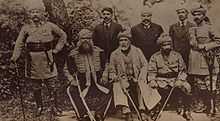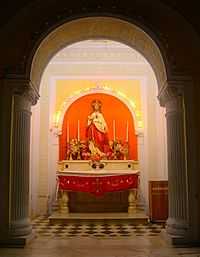Sardhana
| Sardhana | |
|---|---|
| city | |
 Sardhana Location in Uttar Pradesh, India | |
| Coordinates: 29°09′N 77°37′E / 29.15°N 77.62°ECoordinates: 29°09′N 77°37′E / 29.15°N 77.62°E | |
| Country |
|
| State | Uttar Pradesh |
| District | Meerut |
| Elevation | 226 m (741 ft) |
| Population (2001) | |
| • Total | 47,970 |
| Languages | |
| • Official | Hindi |
| Time zone | IST (UTC+5:30) |
Sardhana is a town and a municipal board in Meerut district in the Indian state of Uttar Pradesh. It is located 85 km (53 mi) northeast of New Delhi, and 13 mi from Meerut. Sardhana is famous for its cloth industry and Church.
History
Being close to Hastinapur, which is also in Meerut district, the capital of Kauravas of Mahabharata, Sardhana is also known for the ancient Mahadev Temple that is believed to be dating from the Mahabharata period. It was here that the Pandavas prayed before leaving for the Lakshagrah, the notorious palace made of lac by Duryodhana, at the confluence of the Hindon and Krishna rivers (Kali River, Kali Nadi). This palace was located at Varnavrat, the present Barnava, where the prince resided with their mother Kunti.[1]
In the 19th century, Sardhana was the capital of the Begum Samru, born as Farzana Zebunisa in 1751, and considered to be the only Catholic ruler in India. She married in her early teens, a mercenary soldier Walter Reinhardt Sombre of Luxembourg, who was operating in India. Samru is but a mispronunciation of his surname Sombre. On his death in 1778 she succeeded to the command of his mercenary troops, and subsequently converted to Catholicism in 1781, under the name Johanna.[2][3][4]
During her lifetime she supported financially many charitable and religious institutions. She also obtained from the Holy See, the promotion of Father Giulio Cesare, one of the members of the Agra Mission, to the episcopal dignity, and later Pope Gregory XVI wrote to her, and sent her tokens of his paternal approbation.[3][5] The church she built in 1822, became a cathedral for a short time, with its own bishop. The Bishop's Palace has become a girls school. Her original palace has now become a seminary for training priests. The New Palace has become the boys school. In December 1961, Pope John XXIII conferred the dignity of Minor Basilica to the church, now known as Basilica of Our Lady of Graces. This dignity is given only on churches that are both beautiful and historically famous.[6]

It was also ruled by the Nawab of Sardhana, Syed Amjad Ali Shah, a grandson of Nawab Jan Fishan Khan, chief of the Paghman tribe, who came to India in 1842 after Begum Samru died. Amjad Ali Shah's son, Sirdar Ikbal Ali Shah, was born there. Sirdar Ikbal Ali Shah was the father of the Sufi teacher and writer Idries Shah.
In 1901, it was the headquarters of a Tehsil, by the same name, in Meerut district, United Provinces of Agra and Oudh, and had a population of 12, 467.[2]
Sardhana is also famous for Maulana Sadiq Husain Sardhanwi, a scholar and novilist of Urdu literature.
Sardhana Municipal Board organise a Mela after Nauchandi in Meerut City called Boodha Babu Mela every year. Sardhana has a very successful central government school Jawahar Navodaya Vidyalaya, whose children had gone to US for new formulating a new formula in maths and to Japan for scout guide purpose.
Raja Deen Dayal, the first photogragher of India born at Sardhana in the 19th century, patronised by Nizam of Hyderabad (Deccan) Mir Mehboob Ali is also the one of jwell from this town. Jawahar Navodaya Vidhyalaya is also located in Sardhana, Village Bhamori is known for freedom fighting moments. There is a famous temple known as Prachin Shri Shiv Mandir located in Moh -Bhatwara.
Demographics

As of 2001 India census,[7] Sardhana had a population of 47,970. Males constitute 52% of the population and females 48%. Sardhana has an average literacy rate of 48%, lower than the national average of 59.5%: male literacy is 55%, and female literacy is 40%. In Sardhana, 18% of the population is under 6 years of age. The Main communities in sardhana are Jains, Gujjars, Tyagis, Rajputs and Muslims.
Mahapanchayat
There is called a mahapanchayat (great council) of 40 villages on 29 September 2013 to protest against the Uttar Pradesh government charging the local BJP MLA Sangeet Singh Som under the stringent National Security Act. The crowd becomes violent when the police began to brandish sticks. The situation turned tense when a rumour spread that a youth injured in police action had died. Crowd set fire police jeeps and other vehicles.[8]
References
- ↑ Epic Proportion: Sardhana - There’s more to Sardhana than the church.. The Economic Times, March 6, 2008.
- ↑ 2.0 2.1 The Imperial Gazetteer of India, v. 22, p. 105, Oxford, 1908. Retrieved from here
- ↑ 3.0 3.1 Sardhana
 This article incorporates text from a publication now in the public domain: Chisholm, Hugh, ed. (1911). Encyclopædia Britannica (11th ed.). Cambridge University Press..
This article incorporates text from a publication now in the public domain: Chisholm, Hugh, ed. (1911). Encyclopædia Britannica (11th ed.). Cambridge University Press.. - ↑ Sardhana to find a new place on tourism map by Atiq Khan. The Hindu, August 31, 2007.
- ↑ Catholic Encyclopedia (1913)/Agra wikisource.
- ↑ Church that Begum Samru built The Tribune, 11 November 2007.
- ↑ "Census of India 2001: Data from the 2001 Census, including cities, villages and towns (Provisional)". Census Commission of India. Archived from the original on 2004-06-16. Retrieved 2008-11-01.
- ↑ "20 injured in police clashes over Meerut mahapanchayat". The Times of India. 30 September 2013.
External links
| ||||||||||